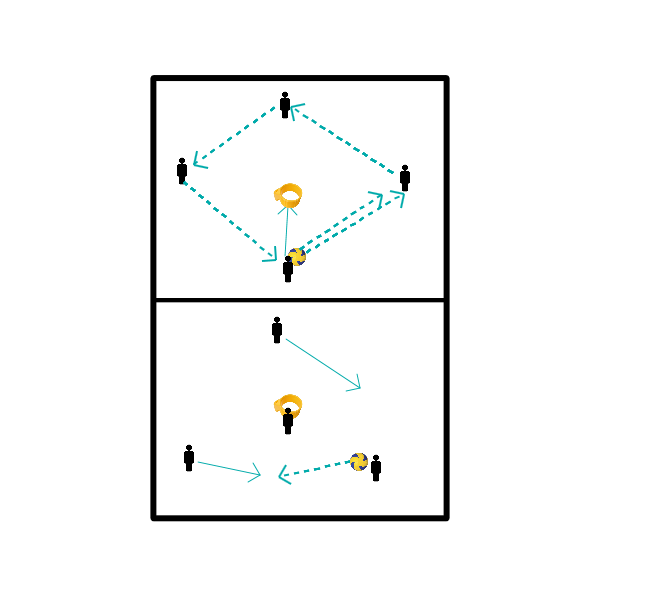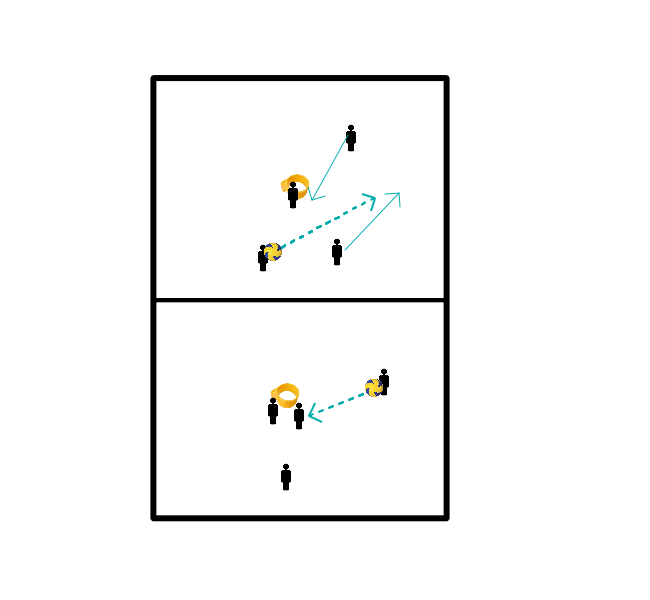Korfball drills for technique defense
- Two pairs at a basket.
- Number one shoots, number two duels for the catch.
- If you have the ball first, play the ball to your teammate who can then shoot.
- Change every goal, the first to score five goals wins the game.
- points of interest:
- Good blocking of opponent without foul
In brief:
- Practicing various forms of the shot in a fun competition format.
Organisation:
- Each group has a basket and a ball, the baskets are next to each other.
- The first assignment for the groups is: score 10 goals.
- In the meantime the trainer walks around all over the place, giving encouragement or correcting here and there.
- He has a piece of paper with a list of instructions.
- If someone comes to get the next assignment, first ask which assignment has just been completed (this can vary considerably over time) and then give the next assignment.
Tasks:
- Make 10 goals, in front of the basket.
- Throw over 15 times with 2 hands.
- Scoring 8 goals, behind the basket
- Pass the ball 15 times with 1 hand.
Objective:
- To teach the children to follow their direct opponent at all times,
- The defender always remains between the post and the girl.
Organisation:
- The children stand in pairs near a basket.
- One of the two is defender, the other attacker.
- The attacker makes movements around the basket (towards, away from, left, right, etc.).
- The defender constantly makes sure she stays in the right place between the basket and the girl.
- After a few minutes, switch. Changing pairs.
Start by discussing defenses. Why do we do it? How do we do it?
In short: starting exercise for defending, where everyone has to follow the movements of the trainer.
Organisation: The players are spread out in the room with a distance of at least 4 metres between them. Everyone stands facing the trainer, who is about 8 metres in front of the group.
a) The trainer walks at a steady pace towards the group. The players must now walk backwards at the same pace, so that the distance to the trainer remains the same. After about ten meters, the trainer stops and walks backwards away from the group. The players also have to stop and walk forwards. The trainer gradually increases the pace and makes sure to walk forwards and backwards at different distances.
b ) As a., but now the trainer walks at a steady pace to the left, the players walk to the right. This way the players walk continuously alternating to the left and to the right, over ever changing distances, at an ever increasing pace.
c ) As a., but now it is important that the players react as fast as possible. The distance between the players should also remain the same. The tempo is high.
d ) Like b., but also at high speed and with a quick reaction. The trainer can verbally support her movements to encourage: "to the left, to the right, faster, yes, good girl! A nice variation that requires more concentration of the players: occasionally shout 'to the left', and then deliberately walk to the right! The command was: follow me, so the players have to follow the movements.
e ) The trainer now walks alternately in 4 different directions, which the players have to follow (combination of c. and d.). The pace is quite high. In principle, this is already a normal defensive exercise. Especially if we move on to f:
f ) As e., but the trainer brings clear tempo changes to her running. She usually runs at a steady pace, but occasionally there is a significant acceleration The players have to react to it immediately! Variations: It may happen that the trainer gets tired herself during this exercise. Or she may have forgotten her korfball shoes (of course it's a shame, but it can happen), or she may be injured. Then there are two solutions possible:
1 ) Not the trainer stands in front of the group, but one of the players, who has been explained the intention beforehand by the trainer. Many (especially children) will find this fun to do. The danger is that there will be more 'gossiping'.
2) The trainer stands in front of the group and indicates with her arms what has to happen: if the left arm is stretched out, the group has to walk to the right, if the arms are brought backwards with a beckoning movement, the group has to walk forwards, etc. The tempo changes are indicated by the trainer. The trainer indicates the changes in pace verbally: 'calm walk,.... And now a little faster, .... pace! ... and again calmly ....'
Tapping or blocking the ball is, just like blocking the shot, largely a matter of feeling. That is why it is important to perform the same exercise against a different opponent. Because this person throws differently, the exercise will be completely different.
3 attackers with 1 ball and 1 defender. In a small square, the attackers have to play around as often as possible. When the defender intercepts (or just touches the ball) the count starts over. The defender who has had the least number of passes within 1 minute wins.
- Make 2 squares of 4.
- The attack takes the ball from the trainers.
- When the defence has intercepted the ball, they first pass it back to the trainers.
- When a goal is scored, the team gets a bonus and can take the ball back out.
2 children are standing near a basket. One attacker and one defender.
- The attacker may move around the basket, towards the basket and away from the basket.
- The defender always stays with his back to the basket and follows the defender.
- Do this for 20 seconds at a time.
For some extra difficulty, the attacker can do tempo changes.
Start line-up
Three groups at the first pawns.
Exercise
The first in line runs to the hoop and goes through the hoop from the bottom, so the hoop goes over their head. Then he goes through the defense stance to pawn two. Turn around and make short passes (left, right) to the next pawn. From there, start to pass the ball. After that, go to the pole for a shot. Then back to the start, tap, next. There are two points per person. First team with six points wins.
Defensive stance:
Back out and through the knees with your arm up.

Start line-up
Two groups at the first two pawns.
Exercise
The first one in line runs to the basket lying on the ground and goes through it, so the basket goes over their head. Then he runs through the defence posture to pawn two and turns around it 4 times. Finally, he runs to pawn 3 and tries to score (3 attempts) before he can run back to pawn 1 and hit the next one in line.
Defensive stance:
Backwards and through the knees with your arm up.
Distance setup:
Hoop from pawn 1: 5 meters.
Pawn 2 from hoop: 5 meter.
Pawn 3 from pawn 2: 5 meter.
Pole from pawn 3: 4 meters.

Start line-up
Two groups at the first two pawns.
Exercise
- The first in line runs to the hoop and goes through the hoop from the bottom, so the hoop goes over their heads.
- Then he runs through the defence posture to pawn two and circles this in 4 circles.
- Finally, he runs to pawn 3 and scores before he can run back to pawn 1 and tap the next one in line.
Set-up distance:
Hoop from pawn 1: 5 meters.
Pawn 2 from the hoop: 5 meter.
Pawn 3 from pawn 2: 5 meter.
Pole from pawn 3: 4 meter.

- Make 2 squares of 4.
- The attack takes the ball from the trainers.
- When the defence has intercepted the ball, they first pass it back to the trainers.
- When a goal is scored, the team gets a bonus and can take the ball back out.
Do give orders, for example:
- Start in a diamond. Let the ball go around 1 time.
- The player in front throws the ball next to him/her one more time and catches it.
- The other players continue playing. The player who has the ball now chooses whether he wants to throw to the left or to the right. The other players run to the ball to pick it up. The ball is thrown and the player immediately runs a long line.
The long line is nudged and the thrower comes alongside. The other player walks behind the basket to walk into the support. The other two are going to attack.


Inshort: practise various forms of the shot in a fun competition format.
Organisation: each group a basket and a ball, the baskets are preferably (but not absolutely necessary) arranged in a circle or rectangle. The number of people per group is less important (all groups should be about the same size).
Pawns set up at 1,3,5 metres
The first assignment for the groups is: make 10 goals. When you are done, the creator of the last goal goes to the trainer to get the next assignment. Which group will have completed all assignments first?
The trainer walks around the room, encouraging or correcting the players. He has a piece of paper with a list of assignments. When someone comes to get the next assignment, first ask him which assignment he just completed (after a while this can vary considerably) and then give the next one. Here's an example: 10 walk-through balls, 15 penalty shots, 5 shots from 8 meters, 10 walk-through balls from behind the basket, 5 dodgeballs next to the post, 10 shots from 6 meters. Everything is possible of course, a lot of momentum comes from keeping the number of goals to be scored small.
Tasks:
- 6 scores from 2,5 meter in front of the basket
- 6 scores from 1 meter in front of the basket
- 6 scores from 6 meter in front of the basket
- 6 scores from 2,5 meter behind the basket
- 6 scores from 1 meter behind the basket
- 6 scores from 6 meters behind the basket








